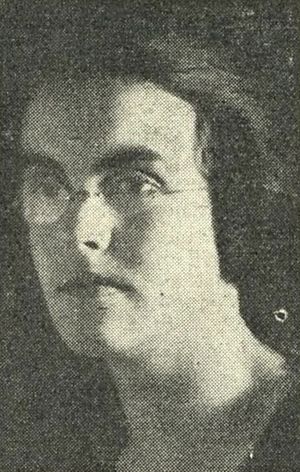Beatrice Darbyshire facts for kids
Quick facts for kids
Beatrice Darbyshire
|
|
|---|---|

Darbyshire in 1929
|
|
| Born |
Beatrice Dean Darbyshire
31 March 1901 Perth, Western Australia
|
| Died | 31 July 1988 Mosman Park, Western Australia
|
Beatrice Dean Darbyshire (born March 31, 1901 – died July 31, 1988) was a talented artist from Australia. She was especially known for her etchings. Etchings are a type of printmaking where an image is carved into a metal plate using acid. Two of her etchings were chosen to be shown at a very big event called the British Empire Exhibition in London in 1924 and 1925.
Early Life and Learning
Beatrice Darbyshire was born in Perth, Western Australia, on March 31, 1901. Her father, Benjamin Harvie Darbyshire, was a barrister (a type of lawyer).
She started her schooling in Perth. Later, she went to an all-girls school called The Hermitage in Geelong, Victoria, from 1915 to 1917. Beatrice loved art from a young age. She studied art with a teacher named Henri Van Raalte in 1913 and 1914. After her time at The Hermitage, she went back to learn from him again. Another artist, Edith Trethowan, was one of her classmates.
Her Career
Art
Beatrice Darbyshire's artwork was first shown to the public at the Art Gallery of Western Australia. This was part of an exhibition put on by the Western Institute of Artists.
In 1924, her teacher Henri Van Raalte encouraged her to travel to London. There, she continued her art studies at two famous schools: first the Slade School of Fine Art, and then the Royal College of Art. She finished her studies and graduated in 1927.
Two of her special etchings were picked for a major event. These were The Cowshed, Balingup and In the Blackwood Country. They were displayed at the British Empire Exhibition in London in both 1924 and 1925. This was a huge honor for her work.
In 1929, she had more artworks shown at the University Art Club Exhibition. One of these was bought by the Art Gallery of Western Australia for their collection. The next year, in 1930, she was one of the Australian artists whose work was shown at the British Empire Academy in London.
Beatrice also wrote about art. She wrote a two-part article called "Etchings" for a publication named The Dawn. This was a newsletter that focused on women's issues. In her articles, she explained how etchings are made. She also wrote about famous artists like Durer, Rembrandt, and Charles Meryon who used this art technique.
Years later, in 1981, an exhibition was held in Canberra. It was called "Western Australian Printmakers of the 1920s and 1930s." This show featured artworks by Beatrice Darbyshire, A. B. Webb, and Edith Trethowan. An art historian named Sasha Grishin reviewed the exhibition. He wrote that Beatrice Darbyshire "left a valuable historical record of her time." This means her art helps us understand what life was like back then.
Today, you can find Beatrice Darbyshire's art in several important collections. These include the National Gallery of Australia, the Art Gallery of Western Australia, and the Art Gallery of New South Wales.
Health and Fitness
In 1940, Beatrice Darbyshire took a break from art to focus on health. She left Perth to train as an instructor with the Women's League of Health in Sydney. This league was run by Thea Stanley Hughes.
After she finished her training, Beatrice taught fitness classes in Sydney and Wollongong. She then returned to Perth in 1944. For the next 12 years, she managed the Western Australian branch of the Women's League of Health. She helped many people stay fit and healthy.
Later Life and Death
Beatrice Darbyshire passed away on July 31, 1988. She died in Mosman Park, Western Australia.

